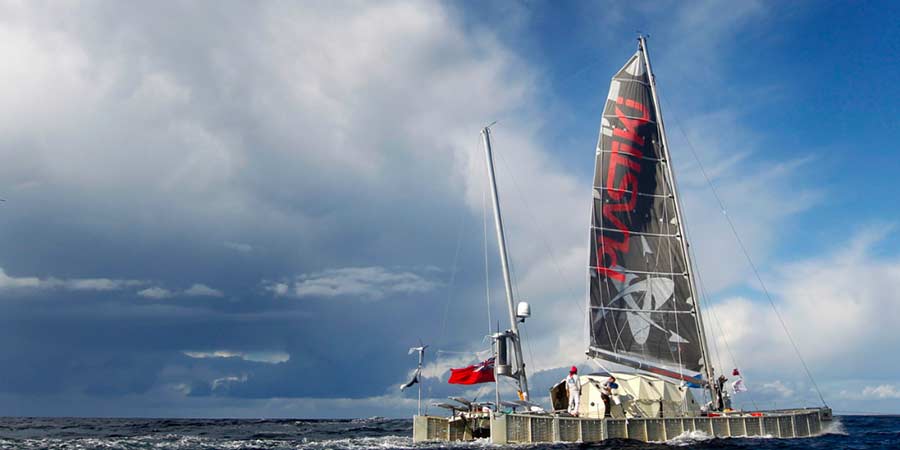In 2006, a group of young adventure-seekers headed by David de Rothschild came up with a crazy idea: to create a completely recyclable boat that would be capable of crossing the ocean. The result was Plastiki: a catamaran measuring 18.28 metres in length and 6.30 metres in width, with hulls made of an incredible 12,500 recyclable plastic bottles.
The boat’s name is a play on the 1947 Kon-Tiki raft used to sail across the Pacific by Norwegian explorer Thor Heyerdahl, and its voyage roughly followed the same route.
On March 20, 2010, the sailing vessel set off from San Francisco, California to cross the Pacific Ocean with a crew of six: British skipper Jo Royle, co-skipper David Thompson, expedition diver Olav Heyerdahl, filmmakers Max Jourdan and Vern Moen, and expedition leader David de Rothschild. The expedition projected landfall in Sydney, Australia and included plans to visit several sites en route of ecological importance or which were susceptible to environmental issues caused by global warming, for instance the current sea level rise, ocean acidification and marine pollution.
Plastiki arrived in Sydney Harbour on July 26, 2010, accompanied by a small flotilla of boats. Shortly afterwards, it was towed to the Australian National Maritime Museum in Darling Harbour, where it was on display until late August.
This 8000-nautical mile journey across the Pacific Ocean from San Francisco to Sydney is a revolutionary expedition of ecological importance with a mission and dream of giving our oceans a voice. Plastic pollution has been plaguing our planet, from the peaks of mountains to the depths of the ocean. Throw-away single-use plastics are the culprit, with over 74 million pounds of plastic bottles floating in our oceans.
Legacy and Impact
The Plastiki Expedition left an indelible mark on environmental activism, capturing global attention and inspiring discussions about sustainable practices. David de Rothschild and his team succeeded in demonstrating that innovative solutions can be found even in the face of seemingly insurmountable challenges.
Continuing the Mission
Beyond the expedition, David de Rothschild has continued his advocacy for environmental conservation. The Plastiki remains a symbol of the possibilities that arise when creativity and passion converge to address environmental issues.
The Plastiki Expedition stands as a testament to the power of collective action and the potential for change when individuals and communities come together to address the challenges facing our planet. It serves as a call to action, urging us all to rethink our relationship with plastic and embrace sustainable practices for the well-being of our oceans and future generations.
But how, you ask, did they build it?
The Plastiki team found the solution to the technological challenge in 2008 by using srPET, a material similar to fibreglass but made entirely of recyclable plastic. The bottles were filled with dry ice and then sealed and heated, to turn the dry ice into carbon dioxide gas and pressurise the bottles, making them rigid.
The Plastiki catamaran, used in the eponymous expedition led by David de Rothschild, was a unique vessel constructed from recycled plastic bottles and other sustainable materials. The innovative design aimed to draw attention to the issue of plastic pollution while showcasing the potential for repurposing plastic waste. Here’s an overview of how the catamaran was built:
Materials:
• The main structural elements of the Plastiki were a series of PET plastic bottles, which are commonly used for beverage containers. These bottles were filled with dry ice to create a rigid and buoyant structure.
• The bottles were connected and assembled into a framework using a combination of recyclable materials, including a recyclable glue made from cashew nuts.
Hull Construction:
• The hulls of the catamaran were made by assembling layers of bottles into a honeycomb structure. This design provided both strength and buoyancy.
• The honeycomb structure was covered with a composite material made from recycled PET plastic and other recyclable materials. This covering served to protect the bottles from ultraviolet (UV) radiation and abrasion.
Design and Stability:
• The catamaran featured two hulls connected by a central platform, creating a stable and seaworthy vessel.
• The design of the Plastiki took inspiration from traditional Polynesian catamarans, adapting their stability for the unique challenges posed by the Pacific Ocean.
Sails and Rigging:
• The Plastiki was equipped with a sail rig designed to harness wind power for propulsion.
• The sail plan was carefully considered to ensure the catamaran’s stability and maneuverability during the expedition.
Interior and Accommodations:
• The interior of the catamaran included living quarters for the crew, storage for supplies, and space for scientific equipment.
• The accommodations were designed to be functional and sustainable, aligning with the expedition’s environmental ethos.
Innovative Features:
• The Plastiki featured other innovative elements, such as a vertical-axis wind turbine and solar panels, contributing to the vessel’s sustainability by harnessing renewable energy sources.
• Testing and Modifications:
• Before setting sail, the Plastiki underwent rigorous testing to ensure its seaworthiness and durability.
• Modifications were made as needed to address any structural or functional challenges identified during testing.
